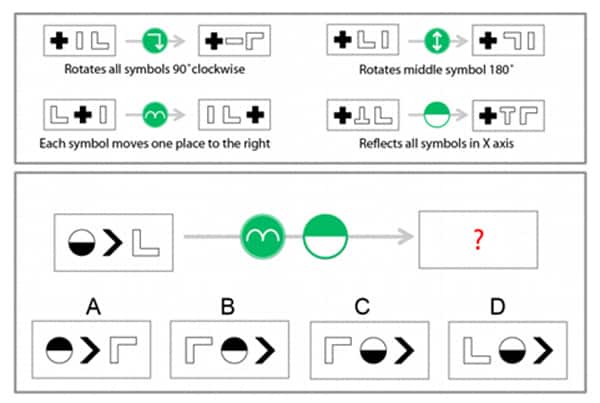Diagrammatic Reasoning Test: The Essential Preparation Guide
A diagrammatic reasoning test is one of the most challenging aptitude tests you can face in job selection. But with the right preparation and practice, you’ll be ready to face it head-on and get a great score – and your dream job too.
Luckily, you’re in the right place!
In this free diagrammatic reasoning test guide we will show you:
- The 3 types of questions to prepare for
- 2 real-world diagrammatic reasoning sample questions (with answers and explanations)
- 4 expert tips to help you succeed
You can find some of the best tailored diagrammatic reasoning practice tests here.
What is a diagrammatic reasoning test?
Diagrammatic reasoning tests assess your ability to identify logical rules and apply them to solve complex problems. They require you to interpret and analyse data, and think critically.
These tests are similar to (and sometimes referred to as) abstract reasoning or inductive reasoning tests. But diagrammatic reasoning tests are typically more specific to the industry and position you’re applying for, and more common in technical or high-level roles like IT, management, finance, engineering and science.
Why employers use diagrammatic reasoning tests in job selection
Questions in diagrammatic reasoning tests are based on diagrams and patterns rather than words or numbers.
Because of this, employers use these tests to assess your general mental ability and other innate skills like problem solving and logical reasoning, instead of skills that depend on your intellect or educational background.
Diagrammatic reasoning tests are a good predictor of high-performing candidates because they require you to think both strategically and analytically.
They show employers if you can learn quickly, grasp complex ideas and understand their implications.
What to expect in a diagrammatic reasoning test
These are computer-based, multiple-choice tests that are held under strictly timed conditions. The test format and time limit will vary slightly between test providers, but a typical diagrammatic reasoning test is made up of 20 questions to be completed in 30 minutes.
The test questions will present you with some visual information such as flow charts or diagrams, and you’ll need to analyse the information to determine its rules and apply them to find the answer. Questions will get more difficult as the test goes on.
There are three main types of questions in a diagrammatic reasoning test:
1. Operators
You’ll get a list of “operators” followed by a diagram.
The operators all affect the diagram in some way, and you must apply specific operators to figure out which diagram is correct.(We’ll show you an example of this in the next section, so sit tight!)
2. Inputs and Outputs
You’ll get operators in these questions too, but won’t know how they all affect the diagram.
Instead, the diagram will show operators in small boxes and “inputs” and “outputs” in large boxes, and you need to figure out what effect the operators are having on the inputs to produce the correct output.
3. Comparing Sets
You’ll get two sets of figures followed by one figure on its own.
You must decide which set the figure belongs to, or if it doesn’t belong to either set.
Diagrammatic reasoning test practice questions (and answers)
Now let’s take a look at some examples of diagrammatic reasoning test questions from AssessmentDay to give you some more context. We’ll also explain how to answer the questions.
First up, here’s one on Operators:
Q1. Which diagram replaces the question mark?
(A)
(B)
(C)
(D)
ANSWER
The correct answer is (B).
Here, you need to apply the two bottom operators to each symbol in the diagram, first moving them all one place to the right and then reflecting them.
Example question 2
Now try a Comparing Sets question:
Which set does the Figure belong to?
(A) Set A
(B) Set B
(C) Neither set A nor set B
ANSWER
The correct answer is (B).
Here, you can see that each box in Set A has one black star and two white stars behind the lines. In Set B, each box has one black star and one white star behind the lines.
The figure has one black star and one white star behind the lines.
You can find more professional practice tests here.
Diagrammatic reasoning test video tutorial
Have a watch of this video from GraduateMonkey where they look at working out input shapes…
How to pass your diagrammatic reasoning test: 4 pro tips
#1: Clarify which test provider you’ll be using
There are a few major suppliers of diagrammatic reasoning tests, and each supplier’s test is slightly different in its format and timing.
If you’ve been asked to take a diagrammatic reasoning test, make sure to ask who the test provider is.
That way, you can spend your preparation time more wisely by taking practice tests from the same provider.
The three main test suppliers are Saville, Cubiks and SHL. Click on the links to find more information and practice tests for each one.
#2: Practice under exam conditions
Once you know which diagrammatic reasoning test to prepare for, practice taking it in real test conditions.
Answer all the questions in one sitting, time yourself and do your best to stick to the time limit.
Doing this will help you know what to expect on the day of your test, and give you the experience to approach it with confidence.
Also make sure to practice regularly in the lead-up to your test. We recommend at least 30 minutes a day for two weeks before the test, but the more practice time you allow yourself, the better prepared you’ll be.
We always recommend these diagrammatic reasoning practice tests.
#3: Work on your problem solving skills
You can improve your logic and problem solving ability by training your brain to think more critically.
Brainteasers, crossword puzzles and sudoku can all help you learn to spot patterns and break codes faster and more accurately.
So pick up a puzzle book from a newsagent or download a few puzzle games on your phone and spend some time working through them.
#4: Make use of scrap paper
You’re allowed to use a pen and paper during the test itself, and we highly recommend that you do! Take plenty of notes as you work through the questions.
Many of the questions will involve multiple rules, and if you don’t write them down as you go, you can quickly lose track.
Jot down the operation of each symbol as you work them out, rules and functions that may be connected, and anything else you don’t want to forget.
Good luck! You’ve got this.
Some more guides to help you succeed…
- Numerical Reasoning: Numerical Reasoning Test Guide: 5 Proven Tips to Succeed
- Verbal Reasoning: Verbal Reasoning Test: What You Need to Know to Pass
- UKCAT: UKCAT Test Guide: 4 Secrets to UKCAT Success 2020
- Watson-Glaser: Watson-Glaser Test: Everything You Need to Know to Pass
- Mechanical Comprehension: Mechanical Comprehension Test Guide 2020





